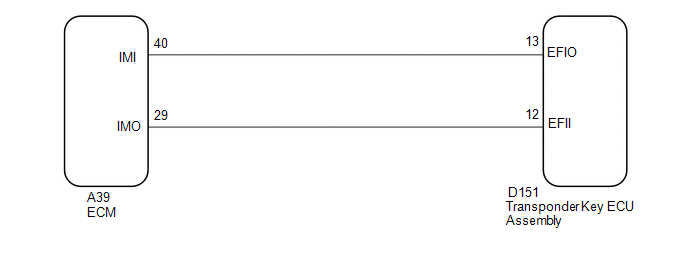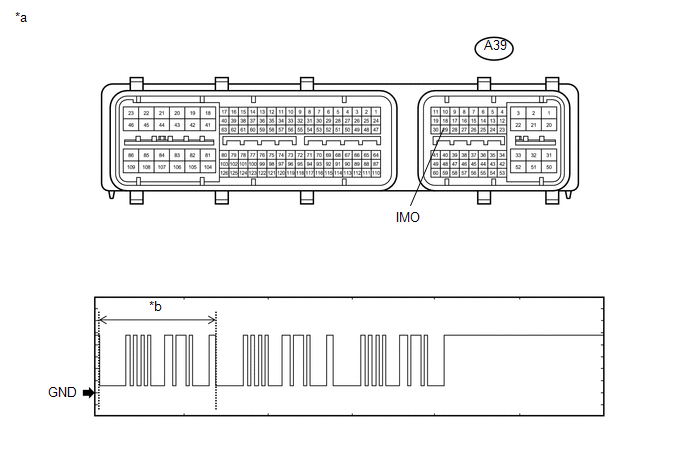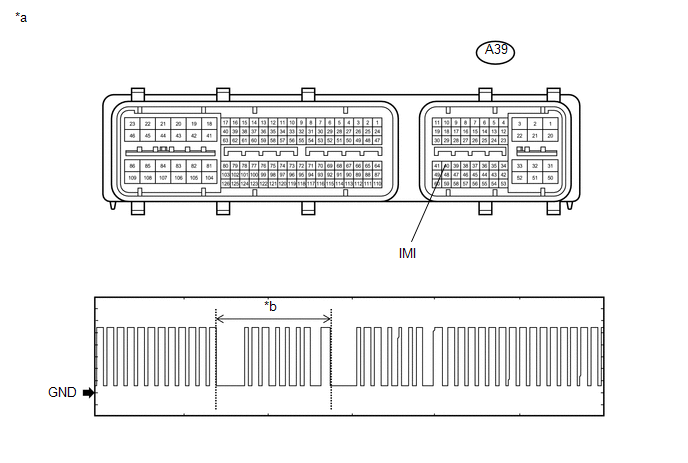- A malfunction occurs in the communication or communication lines between the ECM and transponder key ECU assembly.
- A communication code cannot be verified during communication between the ECM and transponder key ECU assembly.
| Last Modified: 08-28-2024 | 6.11:8.1.0 | Doc ID: RM100000000VJL2 |
| Model Year Start: 2016 | Model: Sienna | Prod Date Range: [12/2015 - 08/2016] |
| Title: THEFT DETERRENT / KEYLESS ENTRY: ENGINE IMMOBILISER SYSTEM(w/o Smart Key System): B2799; Engine Immobiliser System Malfunction; 2016 MY Sienna [12/2015 - 08/2016] | ||
|
DTC |
B2799 |
Engine Immobiliser System Malfunction |
DESCRIPTION
This DTC is stored when one of the following occurs: 1) the ECM detects errors in its own communications with the transponder key ECU assembly; 2) the ECM detects errors in the communication lines; or 3) the ECU - ECM communication ID between the transponder key ECU assembly and ECM is different and an engine start is attempted. Before troubleshooting for this DTC, make sure no engine immobiliser DTCs are output. If output, troubleshoot the engine immobiliser DTCs first.
|
DTC Code |
DTC Detection Condition |
Trouble Area |
|---|---|---|
|
B2799 |
Either condition is met: |
|
WIRING DIAGRAM

CAUTION / NOTICE / HINT
NOTICE:
-
When replacing the transponder key ECU assembly, refer to the Registration (See page
![2016 - 2020 MY Sienna [12/2015 - ]; THEFT DETERRENT / KEYLESS ENTRY: ENGINE IMMOBILISER SYSTEM(w/o Smart Key System): REGISTRATION](/t3Portal/stylegraphics/info.gif) ).
).
-
When replacing the ECM, refer to the INITIALIZATION (See page
![2016 MY Sienna [12/2015 - 08/2016]; 2GR-FE (ENGINE CONTROL): SFI SYSTEM: INITIALIZATION](/t3Portal/stylegraphics/info.gif) ).
).
- After performing repairs, perform the operation that fulfills the DTC output confirmation operation, and then confirm that no DTCs are output again.
PROCEDURE
|
1. |
CLEAR DTC |
(a) Clear the DTCs (See page
![2016 MY Sienna [12/2015 - 08/2016]; THEFT DETERRENT / KEYLESS ENTRY: ENGINE IMMOBILISER SYSTEM(w/o Smart Key System): DTC CHECK / CLEAR](/t3Portal/stylegraphics/info.gif) ).
).
|
|
2. |
CHECK FOR DTC |
(a) Start the engine.
(b) Wait 10 seconds or more.
(c) Check for DTCs (See page
![2016 MY Sienna [12/2015 - 08/2016]; THEFT DETERRENT / KEYLESS ENTRY: ENGINE IMMOBILISER SYSTEM(w/o Smart Key System): DTC CHECK / CLEAR](/t3Portal/stylegraphics/info.gif) ).
).
HINT:
Before checking for DTCs, perform the "DTC Output Confirmation Operation" procedure.
OK:
DTC B2799 is not output.
Result
|
Result |
Proceed to |
|---|---|
|
OK |
A |
|
NG (DTC B2799 is output) |
B |
|
NG (Other DTCs are output) |
C |
| A |

|
| C |

|
|
|
3. |
INSPECT ECM (TERMINAL IMO) |
(a) Using an oscilloscope, check the waveform.

Text in Illustration
|
*a |
Component with harness connected (ECM) |
*b |
Waveform |
Measurement Condition
|
Item |
Content |
|---|---|
|
Tester Connection |
A39-29 (IMO) - Body ground |
|
Tool Setting |
2 V/DIV., 500 ms./DIV. |
|
Condition |
Within 3 seconds after starter operates and initial combustion occurs, or within 3 seconds after ignition switch first turned to ON after battery disconnected and reconnected |
OK:
Waveform is output normally (refer to illustration).
Result
|
Result |
Proceed to |
|---|---|
|
Normal waveform |
A |
|
Terminal IMO stuck low (2.4 V or less) |
B |
|
Terminal IMO stuck high (12 V) or Abnormal waveform |
C |
| B |

|
| C |

|
|
|
4. |
INSPECT ECM (TERMINAL IMI) |
(a) Using an oscilloscope, check the waveform.

Text in Illustration
|
*a |
Component with harness connected (ECM) |
*b |
Waveform |
Measurement Condition
|
Item |
Content |
|---|---|
|
Tester Connection |
A39-40 (IMI) - Body ground |
|
Tool Setting |
2 V/DIV., 500 ms./DIV. |
|
Condition |
Within 3 seconds after starter operates and initial combustion occurs, or within 3 seconds after ignition switch first turned to ON after battery disconnected and reconnected |
OK:
Waveform is output normally (refer to illustration).
Result
|
Result |
Proceed to |
|---|---|
|
Normal waveform |
A |
|
Not output waveform or abnormal waveform |
B |
| B |

|
|
|
5. |
REGISTER ECU COMMUNICATION ID |
(a) Reregister the ECU communication ID (See page
![2016 - 2020 MY Sienna [12/2015 - ]; THEFT DETERRENT / KEYLESS ENTRY: ENGINE IMMOBILISER SYSTEM(w/o Smart Key System): REGISTRATION](/t3Portal/stylegraphics/info.gif) ).
).
|
|
6. |
CHECK WHETHER ENGINE STARTS |
(a) Check that the engine starts with an already registered vehicle key.
OK:
Engine starts normally.
| OK |

|
END (COMMUNICATION ID REGISTRATION WAS DEFECTIVE) |
| NG |

|
|
7. |
INSPECT ECM (IMO TERMINAL VOLTAGE) |
|
(a) Disconnect the A39 ECM connector. |
|
(b) Turn the ignition switch to ON.
(c) Measure the voltage according to the value(s) in the table below.
Result
|
Result |
Proceed to |
|---|---|
|
Terminal IMO stuck low (2.4 V or less) |
A |
|
Terminal IMO stuck high (12 V) |
B |
Text in Illustration
|
*a |
Front view of wire harness connector (to ECM) |
| B |

|
|
|
8. |
CHECK HARNESS AND CONNECTOR (ECM - TRANSPONDER KEY ECU AND BODY GROUND) |
(a) Disconnect the D151 transponder key ECU assembly connector.
(b) Disconnect the A39 ECM connector.
(c) Measure the resistance according to the value(s) in the table below.
Standard Resistance:
|
Tester Connection |
Condition |
Specified Condition |
|---|---|---|
|
D151-12 (EFII) - A39-29 (IMO) |
Always |
Below 1 Ω |
|
D151-12 (EFII) or A39-29 (IMO) - Body ground |
Always |
10 kΩ or higher |
| NG |

|
REPAIR OR REPLACE HARNESS OR CONNECTOR |
|
|
9. |
REPLACE TRANSPONDER KEY ECU ASSEMBLY |
(a) Replace the transponder key ECU assembly (See page
![2016 - 2020 MY Sienna [12/2015 - ]; THEFT DETERRENT / KEYLESS ENTRY: TRANSPONDER KEY ECU: REMOVAL](/t3Portal/stylegraphics/info.gif) ).
).
|
|
10. |
REGISTER KEY |
(a) Reregister the key (See page
![2016 - 2020 MY Sienna [12/2015 - ]; THEFT DETERRENT / KEYLESS ENTRY: ENGINE IMMOBILISER SYSTEM(w/o Smart Key System): REGISTRATION](/t3Portal/stylegraphics/info.gif) ).
).
|
|
11. |
REGISTER ECU COMMUNICATION ID |
(a) Reregister the ECU communication ID (See page
![2016 - 2020 MY Sienna [12/2015 - ]; THEFT DETERRENT / KEYLESS ENTRY: ENGINE IMMOBILISER SYSTEM(w/o Smart Key System): REGISTRATION](/t3Portal/stylegraphics/info.gif) ).
).
|
|
12. |
CHECK WHETHER ENGINE STARTS |
(a) Check that the engine starts with an already registered vehicle key.
OK:
Engine starts normally.
| OK |

|
END (TRANSPONDER KEY ECU ASSEMBLY WAS DEFECTIVE) |
| NG |

|
|
13. |
REPLACE ECM |
(a) Temporarily replace the ECM with a new one (See page
![2016 MY Sienna [12/2015 - 08/2016]; 2GR-FE (ENGINE CONTROL): ECM: REMOVAL](/t3Portal/stylegraphics/info.gif) ).
).
|
|
14. |
REGISTER ECU COMMUNICATION ID |
(a) Reregister the ECU communication ID (See page
![2016 - 2020 MY Sienna [12/2015 - ]; THEFT DETERRENT / KEYLESS ENTRY: ENGINE IMMOBILISER SYSTEM(w/o Smart Key System): REGISTRATION](/t3Portal/stylegraphics/info.gif) ).
).
|
|
15. |
CHECK WHETHER ENGINE STARTS |
(a) Check that the engine starts with the key.
OK:
Engine starts normally.
| OK |

|
END (ECM WAS DEFECTIVE) |
| NG |

|
|
|
|

